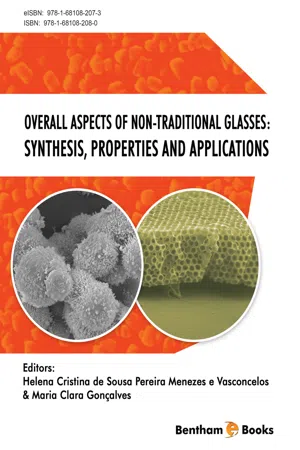Photonic Bandgap Glass-Based Structures
1.. Introduction
Gem opals, wings of butterflies and peacocks, fish scales, beetles, among a large number of other biological and mineral materials exhibit iridescence, strong multiple scattering, and unexpected forbidden wave propagation in certain frequency ranges (Fig. 1). Nanostructured systems are in the basis of such behaviour [1, 2].
Photonic crystals (PCs) are the artificial counterparts. PCs as it is often called photonic band gap materials (PBGs) are artificial composite materials, micro/nanostructured on an optical length scale (e.g. few hundreds of nm). The resulting periodicity in the dielectric constant ε (or in the refractive index n,) is responsible for inhibiting light (of frequencies in the visible or near infra-red range) from propagating through the material as a result of Bragg diffraction [3]. The forbidden frequency range is called a stop band. In PCs the electromagnetic waves within the band gap are completely reflected by the crystal, while spontaneous emission (within the band gap) are totally concealed.
PBGs can be in one, two or three dimensions (1D, 2D or 3D) (Fig. 2), function of the dimensionality of the refractive index periodicity. A complete PBG, where all electromagnetic propagation is disallowed whatever the direction of propagation or the polarization, is only possible in 3D structures. Further, the dielectric constants ratio of the composite materials must be higger than 2.8.
PCs are the optical analogue of electronic bandgap in semiconductors; it is believed that PCs should be able to transfer the full functionality of semiconductor devices into the all optical field, combining high integration with high speed processing.
PCs have attracted much interest due to the innumerous technological applications resulting from the multiple ways in which PCs may control and customize the flow of light, as the inhibition of spontaneous emission processes, the existence of photonic bandgaps (PBGs), or the confinement of light at defects. Besides they promise a large number of applications in different scientific and commercial areas like novel types of waveguides and optical fibers, new filters, high-speed switches, low-threshold microlasers, high-performance LEDs (light emitting diode), photonic for VLSI (very large scale integration), along with novel biological and chemical sensors (see 7. Photonic Crystals Applications).
Traditionally, both top-down and bottom-up approaches have been used to fabricate PCs. The methodology chosen often depends on the dimensionality of the PCs under studied-2D, for example, are often fabricated through gas source molecular beam epitaxy, two-photon lithography, direct-write electron-beam lithography, reactive-ion etching, oxidation processes or holographic methods, all top-down methodologies. 1D and 3D structures are often fabricated through bottom-up sol-gel protocols [2 - 7] (references wherein). All these methods are based and take profit of current nanotechnology processes and fabrication system capable of operating and patterning at the sub wave scale. Fig. (3) shows SEM (scanning electron microscope) pictures of 1D and 2D PCs fabricated on SOI (silicon-on-insulator) technology, by combining electron beam lithography and etching processes; Fig. (4) illustrates SEM micrographs of 3D PCs fabricated by sol-gel methodology.
2.. Photonic crystals-Physical principles
To understand the physical principles behind PCs, it is helpful to start with their electronic analogues. As excellently explained in ref. [3], a crystal can be defined as a periodic arrangement of molecules or atoms repeated in space according to a crystal lattice. The constituents of the crystal (patterns: atoms, ions, molecules) as well as its geometric lattice (and there are 14 Bravais lattices) define the crystal structure which rules the conduction properties of the crystal, i.e., the way electrons will propagate through the crystal periodic potential. Electrons propagate as waves, and waves that meet certain criteria can travel through a periodic potential without scattering. But, in addition, the periodic lattice may inhibit the propagation of some waves, creating gaps in the crystal energy band where electrons are inhibited to propagate in specific directions. Moreover, if the lattice potential is sufficiently strong, a complete band gap, covering all possible propagation directions could be reached. This is what happens, for example, in semiconductor materials where a complete band gap between the valence and conduction energy bands is observed.
In a PC, the periodic die...




